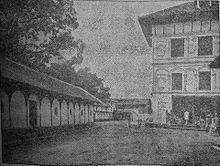Date 19 September 1846 | ||
 | ||
The Kot massacre (Nepali: कोत पर्व|kot parva) took place on 19 September 1846 when Jung Bahadur Rana and his brothers killed about 40 members of the Nepalese palace court including the Prime Minister and a relative of the King, Chautariya Fateh Jung Shah, at the palace armoury (the kot) of Kathmandu. This led to the loss of power by King Rajendra Bikram Shah and the Shah family, resulting in the monarchy by Surendra Bikram Shah and the establishment of the Rana autocracy.
Contents
Background
At the peak of instability in Nepalese politics, a coalition ministry was formed in September 1845, headed by Fateh Jang Chautaria, but the real power behind the throne was General Gagan Singh Bhandari, believed to be the secret lover of Queen Rajya Laxmi Devi, who controlled seven regiments in the army compared to the three under the prime minister. Abhiman Singh and Jung Bahadur Kunwar also served as commanders, each with three regiments. Gagan Singh was found dead on the balcony of his palace during the night of 14 September 1846. The queen commanded Bahadur, who happened to be ready with his regiments, to assemble the entire administrative establishment of the country immediately at the courtyard of the palace armoury. Following the queen's orders, Jang ordered his men to let people inside the Kot but not to let them out without Queen's or his own orders.
Overview
Following the Queen's order, courtiers hurried to Kot as soon as they heard sounds of Bigul. Almost all the courtiers were unarmed, as they responded immediately to the sounds of Bigul at midnight. The armies allocated by Jung Bahadur Rana also had taken the most of the arms of courtiers who had managed to bring them. Queen Laxmi Devi and King Rajendra Bikram Shah were also present in Kot.
At almost midnight, most of the courtiers were present at Kot. Everyone there was full of fears and skeptical thoughts. General Abhiman Singh spoke to the King about the possibility of a massacre. His presence had relieved some of the members present. Abhiman Singh also fetched three troops under his control to Kot.
Prime Minister Chautariya Fateh Jung Shah had still not arrived. Jung Bahadur Rana called his younger brother Bam Bahadur to fetch Fateh Jung.
Emotions ran high among the assembled bands of nobles and their followers, who listened to the Queen give an emotional harangue blaming the Pandes and demanding that Abhiman Singh execute Bir keshar Pande, whom she suspected for the death of Gagan Singh. Abhiman Singh hesitated and looked to the King. The King hesitated and said to punish the guilty only after a proper investigation of the matter. He pointed out that he must have a discussion with Prime Minister regarding this matter and left. He then left Hanuman Dhoka palace and went to the British residency. When he was denied an audience with the Resident at such a late hour, he went to Narayanhiti Palace. In Narayanhiti, King Rajendra had some time alone with the Prime Minister. Either King Rajendra had not wanted to give information about the conditions at Kot or Fateh Jung had not understood the point. In either case, Fateh Jung went to Kot with simple security.
Meanwhile, at Kot, surrounded by Jang Bahadur's regiments, tension grew high as most of the nobles and Prime Minister Fateh Jang Shah gathered there. Seeing a high possibility of bloodshed, Jang Bahadur, Fateh Jang and Abhiman Singh Rana decided that Jang Bahadur and Fateh Jang should try to calm the Queen, and Abhiman Singh Rana Magar, who had disobeyed the Queen's orders, would stay behind. As the two went to find the Queen, Abhiman Singh decided to move his own regiments to Kot, but he was prevented from leaving. Abhiman Singh tried to force his way out, and was killed in the process. After panic ensued, the bloodshed began. Many Thapas, Pandes and Basnyats (Sirupali) died, including Fateh Jang, Khadga Bikram Shah and Dal Bhanjyan Pande. Some escaped by climbing over walls and roofs and even through the drainage systems. Jang Bahadur easily used the situation to eliminate his rivals.
Aftermath
Jang Bahadur made himself Prime Minister immediately after the massacre. Feeling he presented a threat to her power, the Queen conspired to eliminate Jang Bahadur and elevate her son to the throne. The Basnyat Conspiracy—so called because many of its participants belonged to one of the last leading noble families, the Basnyat—was betrayed and its ringleaders were rounded up and executed at Bhandarkhal Parva. A meeting of leading notables, packed with Rana supporters, found the Queen guilty of complicity in the plot, stripped her of her powers, and sent her into exile at Varanasi, along with King Rajendra. The King began plotting his return from India. In 1847, Jang Bahadur informed the troops of the exiled King's activities, announced his dethronement, and elevated Rajendra's son to the throne as Surendra Bikram Shah. King Rajendra Bikram was captured later that year in the Terai and brought back as a prisoner to Bhadgaon, where he spent the rest of his life under house arrest. Jang Bahadur then established the Rana dynasty, which ruled Nepal for more than a century.
